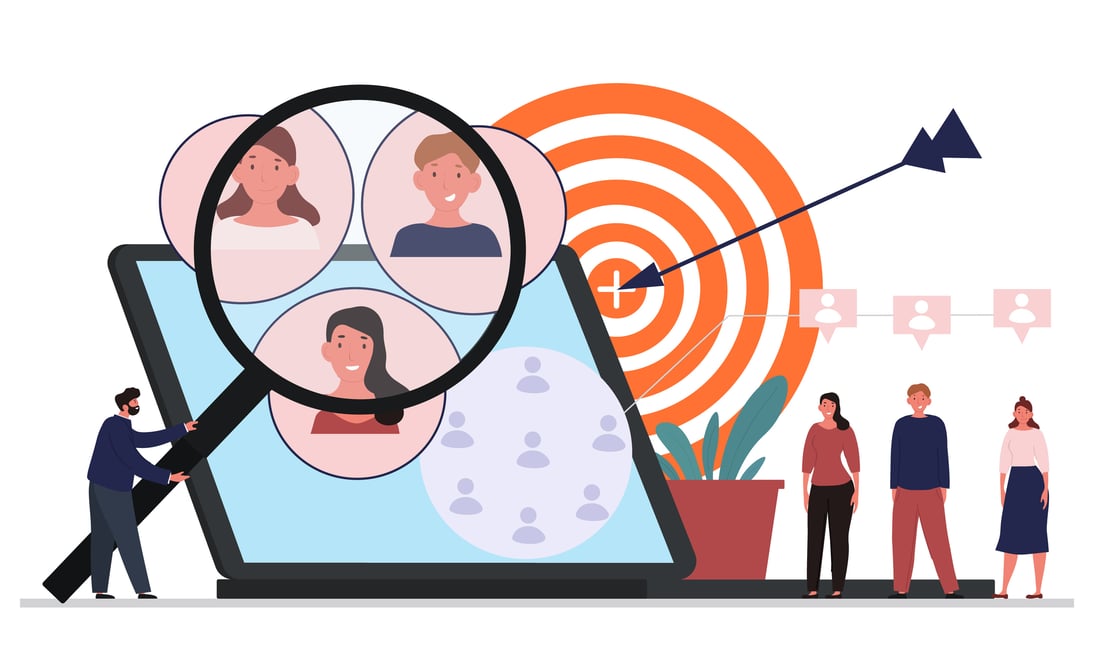Customer Segmentation Models: Types, Benefits & Uses
No two customers are exactly alike. And what your brand does can serve a wide variety of people - which is good for business, but a major marketing challenge. How do you market yourself to so many disparate consumers?
You could take a scattershot approach, throwing everything at the wall and hoping something sticks. Or you could create a laser-focused strategy - one that tailors your marketing efforts to the needs and interests of specific groups of customers. One that segments customers.
Customer segmentation uses different methods, or models, to divide your customers into smaller subgroups defined by shared characteristics. These common characteristics help you create customer profiles, and these in turn lead to increasingly personalized marketing messages that guide customers through their buyers journey.
Understanding your customers is key to the success of your business and customer segmentation is a crucial part of that understanding. Let’s take a closer look at customer segmentation models and how to choose the right ones for your brand.
What is a Customer Segmentation Model?
A customer segmentation model is a way of dividing a wide group of people into smaller groups based on their commonalities. How you divide your larger customer base into those smaller subgroups will vary based on what your brand does and who your customers generally are.
If you’re a business-to-business brand providing accounting services to small and medium-sized businesses, one of your segmentation models may focus on the different industries in which your customers’ businesses operate. You would be using an industry-specific segmentation model.
For a business-to-consumer brand, your customer segmentation models may focus on shared demographics like age, gender, and income level. How you divide your customer base varies on the characteristics you want to target with more personalized messaging.
What Are the Benefits of a Customer Segmentation Model?
Customer segmentation models allow you to create increasingly specific marketing messages tailored to the right person at the right leg of their customer journey. Not only does this build brand trust – by creating the feeling that you understand your customers, their interests, and concerns – it also improves your overall ROI by reducing waste in advertising.
Why waste time on guesswork when a segmentation strategy based on the right-for-you model lets you target exactly who needs what and when?
Further benefits of finding the right customer segmentation model include:
- Increase consumer engagement. Targeted ads and marketing messages connect the right-fit potential consumers to your brand and encourage continued engagement from existing consumers.
- Increase consumer satisfaction and loyalty. The customer that feels seen, heard, and understood by a brand is going to be far more satisfied, and loyal, than the one who feels like they’re just an order number.
Improve ROI. Customer segmentation eliminates wasted time, and therefore money, on marketing efforts that don’t target the right audience. When you understand your consumers and what they need, you can help them fill that need faster and more efficiently.
What are the Types of Customer Segmentation Models?

Successful customer segmentation is not a one size fits all approach. There are a number of different models to explore:
Demographic Segmentation
Demographics are population-related characteristics such as income, education level, gender, and age. The various demographic characteristics can be used together to create segmented customer groups, most useful to brands that sell a variety of products.
For example, a company that sells both mid-range and luxury bath products for women and men may segment their customers by gender as well as income. This way they can create ads that target women with an annual income of $150,000 and separate ads for men with an annual income of $70,000.
Behavioral Segmentation
Behavioral segmentation groups consumers together by habits and behaviors, rather than external demographic factors. For example, purchase history and preferred social media platform usage. You can focus ads on a certain social platform to reach and/or create reminder or sales emails to regular or repeat online buyers.
Psychographic Segmentation
Psychographic segmentation dives even deeper into the internal workings of your consumers by grouping them together based on psychological characteristics, including personality, habits, beliefs, and interests.
Psychographics are great for lifestyle brands that want to align themselves with consumers who live or aspire to live the lifestyle that the brand promotes. Brands that sell outdoor camping gear, for example, want to connect with outdoor and travel enthusiasts.
Geographic Segmentation
Geographic location is important to brands in a number of industries. Real estate agencies, for example, want to connect with homeowners selling their homes, potential buyers, and people looking to relocate to a specific area.
Other businesses may sell products tailored to people living in particular climates. Understanding the needs and challenges of consumers living in different locations is a core element of successfully marketing your products or services in those locales.
Technographic Segmentation
Technographic segmentation, or creating subgroups and customer profiles around the technology your consumers use, is becoming increasingly popular. As more businesses have moved their operations online, this has opened the door to growth in industries like SaaS and online marketing analytics.
Technographic segmentation lets you target consumers that use different types of software or online services in a highly personalized fashion.
Firmographic Segmentation
Millennials vs. Gen X’ers vs. Gen Z vs. Boomers – we’re becoming more and more comfortable with the idea of these generational divides. So much so that firmographic segmentation, or creating subgroups simply around the decades or eras into which your consumers were born, is also on the rise.
And it makes sense – someone born in 1980 will be at a different stage of life, with different needs and concerns, than someone born in 2000.
Needs-Based Segmentation
Needs-based segmentation begins with a simple question: Who needs what you’ve got?
Dividing your consumers into groups around their needs is a great way to keep your marketing messages focused tightly on your products or services and how they meet those needs. A clothing company can market office casual wear to business professionals, athletic gear to yoga enthusiasts, and kids' clothing to families.
Value-Based Segmentation
This model takes the lens and focuses it more directly on what serves your brand. Which group or groups of customers are currently providing the most value – the most return business, the highest return on your ROI?
Using lifetime value as your measuring stick, you can target your marketing messages to the consumers that are your biggest supporters and focus on continuing to build that loyalty and trust.
5 Questions to Ask to Find the Right Segmentation Model for Your Business
Customer segmentation isn’t a one-and-done thing. It takes a fair amount of trial and error to dial into the segmented groups that provide you with the most value, insight, and ROI. Don’t be afraid to explore a variety of models or to get into the habit of reassessing the models you currently use to create your customer segmentation strategy.

To help you choose which model or models work best for you, answer these questions:
1. What is your immediate goal?
Whether your goal is to launch a new product or service, raise your rate of returning customers or simply improve your overall sales, having a specific marketing goal in mind is the first step to refining your customer segmentation and choosing the right-for-you, right-for-now customer segmentation model.
2. What’s the largest segment that will help you reach that goal?
If your goal is to sell more of a specific product, ask yourself who is most likely to need – and therefore purchase – that product? Don’t worry if you get a very broad answer to this question.
This is the initial step of taking a large group of consumers and beginning to divide it into smaller segments. If your goal is to sell more hiking boots, “hikers” is the perfect place to start.
3. Who makes up that broad segment?
Breaking that larger segment down into smaller subgroups involves understanding the general characteristics of that group. To continue the hiking boot analogy - who buys hiking boots? Can you break that answer down by age, income, personality, geographic location, or something else?
Chances are you’ll have more than one answer. Hiking enthusiasts can be found in a number of different segments, such as demographic, psychographic, and geographic.
4. What is the best segmentation model for your goal?
Keep your goal in mind when diving deeper into the wants and needs of your larger segmented group. For the goal of selling more hiking boots, further defining what kind of boots you want to sell will help you get closer to that target segment.
If the boots you want to sell are made for steep and rocky terrain, targeting experienced long-distance hikers and backpackers makes more sense than aiming for casual trail goers.
In that case, you may choose a psychographic segmentation model, creating targeted ads and marketing that focus on the technical specs of your shoes, and how they’re built for the high stress a hardcore hiker will put them through.
5. Do you have the right tools to understand your consumers, and evaluate the success of your segmentation model?
The right data analytics tools are more important than ever. With so much of your marketing happening online, you need to evaluate your efforts across multiple platforms – and combine this data with that from your efforts offline as well.
Once you choose which customer segmentation model you want to use, you need to get the clearest, most up-to-date image possible in order to understand how well that model is working moving forward.
Customer Segmentation Models in Action
Customer segmentation models are used across industries and business types, and each model offers its own unique approach to understanding and targeting different subgroups of consumers.
Using real estate as our focus, let’s look at how three different models are each used to successfully target a business’ ideal consumer:
Psychographic: Homesteaders
For real estate agencies, connecting with the right homebuyer is crucial. Using psychographic segmentation, agents can connect, for example, with prospective homebuyers interested in homesteading by featuring properties that are further out in the country, offer a few clear acres, and are zoned for agriculture.
If an agency has a lot of these types of properties available, understanding the psychographics of various segmented groups will help that agency zero in on the right people to market those properties too.
Geographic: Rural vs. Urban vs. In Between
Real estate agencies are pros at marketing their properties to homebuyers interested in geographically-specific areas. If you’ve ever browsed through a real estate website or print listing you’re probably familiar with terms like “rural retreat,” “downtown nightlife” and “best of both worlds.”
Agencies understand the importance of geographic location and make a point of acenting the rural, urban, or suburban locales of their listing. Connecting prospective buyers with a beautiful property, just for those house hunters to find out it’s in a location they don’t want, is a quick way to lose a sale.
Demographic: Mansion on the Hill
The goal of marketing high-end properties lends itself well to demographic segmentation. Demographics, after all, help you segment customers into groups like age and income level.
Big, luxurious properties with an equally big price tag are pointless to market to customer segments in lower-income brackets, or below a certain age. Most 20 to 25-year-olds don’t have a few million dollars to spend on a property.
Creating a segment that focuses tightly on who has the wherewithal and the inclination to buy high-end allows real estate agencies to close sales quickly.
Getting Started with Customer Segmentation
Customer segmentation is an important part of your overall marketing and advertising strategy. The right message needs to find the right person at the right time along the buyer's journey. Not only does this increase your marketing ROI, and your sales, but it also builds a sense of trust and loyalty around your brand.
With so much of today’s marketing taking place online, creating clear customer profiles based on different segmentation models can be a challenge. You have a lot of data to sort through and make sense of.
Marketing Evolution provides the performance measurement and media planning tools you need to understand your customers’ journey and individual segment behaviors. Optimize your ROI and your segmentation strategy with key insights into your customers’ demographics, psychographics, and more.















.jpg)

